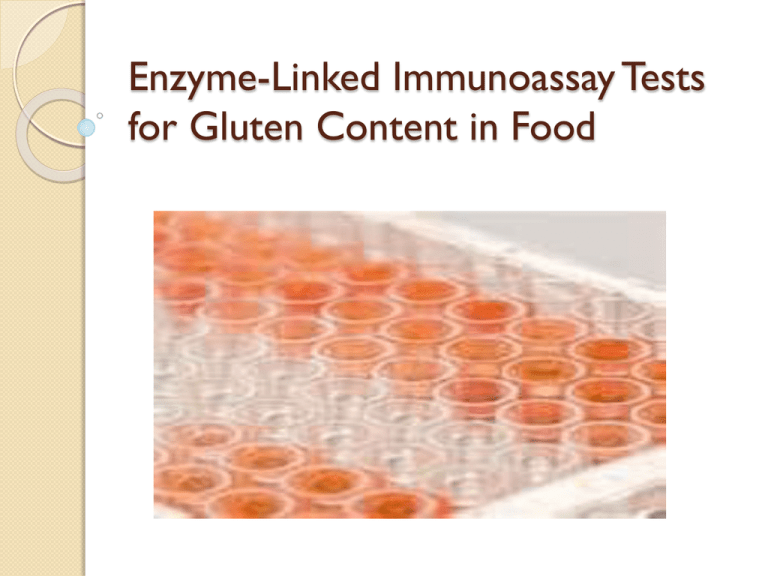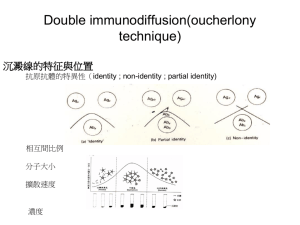Gluten Presentation 04142009
advertisement

Enzyme-Linked Immunoassay Tests for Gluten Content in Food Celiac Disease Nearly 3 million United States citizens suffer from celiac disease Permanent intolerance to gluten Small intestine damaged Symptoms Bloating Cramping Intestinal gas Diarrhea Constipation Treatment for Celiac Disease Gluten Free Diet ◦ Avoid rye, wheat, barley, related cereal grains ◦ May consume rice, buckwheat, corn, quinoa ◦ Oats contain traces gluten that can cause mild symptoms Gluten Free Food Labeling Federal Drug Administration (FDA) ◦ Food Allergen Labeling and Consumer Protection Act of 2004 ◦ Final rule by 2008 still pending ◦ No gluten containing ingredients: rye, wheat, barley, crossbred ◦ Food must be processed to remove gluten ◦ Final food product <20 parts per million (ppm) What Is Gluten? Complexed water-insoluble proteins: gliadin and glutenin Found in rye, wheat and barley seeds Allows dough to bind, gives elasticity, rubberiness Spongy consistency to breads, cakes, other baked products Two Gluten Analysis Methods Available To Food Manufacturers Method One: sandwich w-gliadin enzyme immunoabsorbent assay (ELISA) ◦ Officially approved in 1991 by Association of Analytical Communities (AoAC) ◦ ω means omega (protein in gliadin) • Method Two: competitive sandwich R5 immunoabsorbent assay (R5 ELISA) ◦ Officially approved in 2006 by Codex Alimentarius Commission ◦ Joint body of World Health Organization (WHO) Gluten Testing Performed in food science laboratories ◦ Food scientists, other specialists Sandwich ELISA R5 ELISA Developed by Skerritt and Hill Requires 2 epitopes (antibody binding sites) Underestimates barley protein content from hydrolyzed and partially hydrolyzed proteins (proteins broken apart) Can detect both heated (denatured) and unheated proteins at gluten levels >/150 ppm (150 milligrams per kilogram) Developed by Mendez Requires one specific binding site (R5 monoclonal antibody) Accurately detects highly toxic heat resistant protein Overestimates barley protein content Unable to measure hydrolyzed gluten proteins Can detect both heated and unheated proteins Recognizes all wheat, barley and rye gluten at detection level </3 ppm and able to measure </5 ppm Advantages and Disadvantages of Each Method Terms to Understand Antibody- protein produced by immune system in response to presence of a foreign substance (antigen). Its main function is to neutralize it (make harmless) Antigen- protein, toxin or other foreign substance that causes body to react by producing antibodies (antigen is the reagent) Enzyme- proteins that make reactions occur Epitope- structural site on an antigen (invader) specific to only one particular antibody Terms to Understand Enzyme linked antigen-an enzyme attached to an antigen to be used as a marker to detect a target protein (in this case a gluten rich protein) Horseradish peroxidase (HRP)- an enzyme used to label antigens and their antibodies Microtiter plate- a standard size plate that typically contains 96 small test tube (HRP) containers (wells) Terms to Understand Microwell- test tube container Parts per million- milligrams per kilogram (ratio = one to one million) Substrate- a substance or material on which an enzyme attaches and reacts to make a change occur Solid phase support - microtitre plate wells are example in ELISA Spectrophotometer- instrument that measures amount of ultraviolet light absorbed by a substance Protocol for Sandwich ELISA Step 1 ◦ A plastic test tube (microwell) that contains solid phase support on its base is coated well with purified antibody A Step 2 ◦ An antigen (toxin that contains unknown quantity of gluten) is added to antibody A coated microwell Sandwich ELISA Protocol (continued) Step 3 ◦ Unbound products are removed with a mild detergent Step 4 ◦ Antibody detection joined to enzyme (horseradish peroxidase commonly used to detect antigen: gliadin in gluten detection) ◦ Antibody B recognizes second separate binding site (epitope) on antigen (gliadin bound to antibody A) and binds “sandwich” complex is formed Sandwich ELISA Protocol (continued) Step 4 (continued) o Antibody B is used to increase likelihood that particular gluten is present Step 5 ◦ Colorimetric substrate (substrate that measures gluten content by amount of color intensity) is added to measure the amount of gluten that is detected by labeled second antibody B and its joined enzyme Sandwich ELISA Protocol (continued) Step 6 ◦ Spectrophotometer or ELISA microplate reader ◦ Both instruments measure intensity of ultraviolet light absorbed by substance ◦ Microplate reader reads entire microtiter plate at one time Sandwich ELISA Protocol (continued) Step 7 ◦ Spectrophotometer reads individual microwells ◦ Adjusting spectrophotometer or microplate reader ◦ Adjust to specific optical density such as 450 optical density ◦ Record results for each sample ◦ Graph results Y axis (dependent variable): optical density X axis (independent variable): of concentration of antigen present Plot points on graph Create linear curve How Each Gluten Method Works A Second Diagram of How Each Method Works Sandwich ω-ELISA Method 1. Antibody coated 2. Gliadin () in 3. HRP enzymelabelled 2nd 4. Addition of TMB substrate, plastic micro-well. ethanolic food antibody binds in turn which develops blue extract binds to to gliadin bound to colour in presence of antibody on well. antibody on well. HRP enzyme. How Second Method Works Competitive ELISA Method How Competitive R5 ELISA Works Step 1: ◦ Unlabeled (no enzyme attached) purified primary antibody A is coated onto separate small test tubes (microwells) of a microtiter plate (usually contains 96 wells for ELISA gluten testing method) Step 2 ◦ Unlabeled samples including unknowns and standards (knowns) are added to microwells and incubated until equilibrium (binding site potential has reached its maximum) How Competitive R5 Elisa Works Step 3 ◦ To antibody A, standard, unknown complex in microwell, unlabeled antigen conjugated (attached) to detection enzyme (Strept Avidin Horseradish Peroxidase is added ◦ antigen joined to enzyme will bind to primary antibody A at its unoccupied binding sites the more antigen in unknown and standard (known) the lower number of binding sites available to antigen conjugated to enzyme How Competitive R5 ELISA Works Step 4 Substrate added and incubated enzyme reacts with substrate to release blue color intensity of blue color determines antigen gluten content Step 5 Acid stop solution added stops reaction changes solution from blue to yellow o • How Competitive R5 ELISA Works Step 6 • Use spectrophotometer or microplate reader to determine gluten content by measuring color intensity • Step 7 • Graph results Y axis (dependent variable): optical density X axis (independent variable): concentration antigen present (nanograms) Plot points on graph Create linear curve





